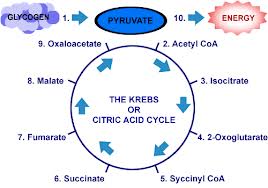
Production of SDH Enzyme & The Krebs/Szent-Gorygi Cycle
The scientific background of what happens with the use of electrical currents to facilitate faster healing, or in some cases start healing, is not well understood. Actually it appears it isn't understood. With the use of the Infrex FRM and the specific protocols to increase muscle strength we look for reasons the combined use of volitional Isometric exercises and estim accelerate healing and increase strength. In "A Review of the Use of Electro-Motor Stimulation in Human Muscles" by Giovanni De Domenico, Strauss and Singer originally published in 1986 there is a summary statement on possible enzymatic activities which may account for the positive outcomes reported.
It appears a given is the maintenance or increased production of the enzyme, succinic dehydrogenase (SDH) enzyme, increases the proliferation of muscle tissue cells for repair or strengthening. The chemical reactions are initiated by the movement of electrons ( negative charges moving toward positive charges or being repelled by other negative charges). The Infrex FRM initiates current flow by moving electrons, negative charged particulate matter, from one electrode to the other using the muscles as the route between the two electrodes. The movement of electrons is the use of a negative charge, stronger than the cellular molecular bonds of the atoms in the cell, and possibly accounts for the increased production of SDH. With more SDH enzyme, muscle growth is initiated and other diseases may be eliminated or retarded.
The reason for increasing muscle growth is after/during exercises for repair or, gaining strength, the body essentially breaks down cell walls, muscle tissues, and immediately thereafter the healing processes occur. The use of the flowing negative charged electrons facilitate faster production of SDH and increase the rates of repair. This can explain how the recovery from surgery from an ACL repair can be cut from 9 months to 9 weeks. It's the volitional exercising, use of the Infrex Biological Frequency currents, that accelerate repair.
Cited below are more materials one can use to understand how the processes may work.
http://muscle.ucsd.edu/musintro/histochem.shtml
What is the SDH gene?
From: http://ghr.nlm.nih.gov/gene/SDHC
What is the normal function of the SDHC gene?
The SDHC gene provides instructions for making one of four subunits of the succinate dehydrogenase (SDH) enzyme. The SDH enzyme plays a critical role in mitochondria, which are structures inside cells that convert the energy from food into a form that cells can use. The SDHC protein helps anchor the SDH enzyme in the mitochondrial membrane.
Within mitochondria, the SDH enzyme links two important cellular pathways in energy conversion: the citric acid cycle (or Krebs cycle) - and oxidative phosphorylation. As part of the citric acid cycle, the SDH enzyme converts a compound called succinate to another compound called fumarate. Negatively charged particles called electrons are released during this reaction. The electrons are transferred through the SDH subunits, including the SDHC protein, to the oxidative phosphorylation pathway. In oxidative phosphorylation, the electrons help create an electrical charge that provides energy for the production of adenosine triphosphate (ATP), the cell's main energy source.
Succinate, the compound on which the SDH enzyme acts, is an oxygen sensor in the cell and can help turn on specific pathways that stimulate cells to grow in a low-oxygen environment (hypoxia). In particular, succinate stabilizes a protein called hypoxia-inducible factor (HIF) by preventing a reaction that would allow HIF to be broken down. HIF controls several important genes involved in cell division and the formation of new blood vessels in a hypoxic environment.
The SDHC gene is a tumor suppressor, which means it prevents cells from growing and dividing in an uncontrolled way.
The below url explains more on SDH and how it is least studied but gaining more importance due to disease prevention qualities such as cancer preventive:
http://www.eurojournals.com/EJSR_51_1_15.pdf


